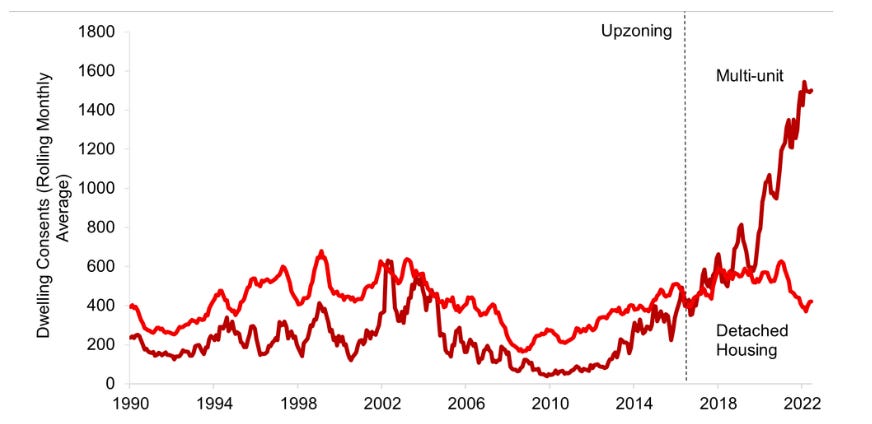There’s a pretty common view that the English-speaking world has a problem with housing. The Financial Times shows this pretty clearly, that the Anglo-world has built less housing per person and see larger price increases.
Those are long-term trends, so I want to look at how they might differ in their more recent track records in terms of building their way out of their respective housing shortages.
To simplify, there are two important ways to look at how much housing your are building:
How many homes are built per person (population)
How many homes are built per new resident (population growth)
This sets up a two dimensional way to look at new housing supply that can be helpful to compare different geographies. I made one comparing Canadian provinces and U.S. states in 2022 here:
But lets extend it to the anglo-world! This time, I'm showing 2015 and 2022, to show how it’s evolved over time too (the arrows point from 2015 to 2022). Given that the average housing unit holds 2-2.5 people, you want to be below that1.
The chart is complicated, so let’s do a simple run-down of the themes by country.
United Kingdom: Tied (with Ireland) for the ugliest of the bunch. The U.K. built very little new housing in 2015, and that has only modestly increased that through 2022. Population growth turned negative, but that’s a horrible way to relieve housing market stress. F
Ireland: In 2015, Ireland build fewer homes than any other peer countries, and only 1 for every 6 new residents, a very bad sign. By 2022, housing construction had ramped up considerably, but the Emerald island continues to underbuild relative to its population growth. D
United States: The U.S. has paired slower population growth with a modest bump in building. This has brought (national) housing supply to a healthy level, but a lot of the “work” is through slower population growth here too. C
Australia: The Aussies have ramped down construction from very high levels in 2015 to only decently high levels. But paired with a population growth slowdown, this has kept new homes to new people contained. B
Canada: Us Canucks are the outliers here. We’ve up our building game decently, but it hasn’t nearly move up enough to match our world-beating population growth, so our new people to new home ratio has moved into the danger zone. It’s not accident that between 2015 and 2022 the housing shortage exploded to beyond Toronto (area) and Vancouver (area) to new regions like southwest Ontario, the Maritimes, and increasingly Alberta. C-
New Zealand: Saving the best for last. The kiwis are the only good news story of the bunch. After being deep in the danger zone in 2015, homebuilding in NZ has ramped up from good to very very good (nearly 1 new home for every 100 new residents). Paired with slower population growth, New Zealand appears to be working down its housing shortage. A!
What explains the success of New Zealand? They are building 4x as many homes as the U.K., adjusting for population.
Maybe they have some magically low interest rates to spur homebuilding? No. The nice part of comparing these countries rate of homebuilding is that interest rates move closely together (except in extreme moments like Ireland during the debt crisis).
Instead, New Zealand, and especially its capital of Auckland (1/3 of NZ pop), embarked on a upzoning campaign in 2016 that greatly expanded how much multi-unit housing could be built2. They allowed it, and the units followed:
Within a few short years, homebuilding surged, and the benefits are being seen in rents as well, with rents in 2022 being lower (after inflation) than 2016.
I hope this will be a useful guide to the individual flavours of the anglo-worlds housing shortages, don’t forget to subscribe :)
You can complicate this by incorporating demographics (single students will want 1 bed units vs. large families who can be 6 in a house) and construction patterns. But IMO that is a marginal dynamic compared to the wide variations seen in the simplified metrics I show.
That was followed by national upzonings










Deny,
What are the details of NZ up zoning? We know the world wants to move to Canada and the USA.
Are our building and zoning codes the problem? In England and Ireland a homes average age is 150 years ,that my estimate. Not a good starter home........
We still need building codes to live in a wild weather climate so so how do we streamline them and avoid becoming Mexico City North?